
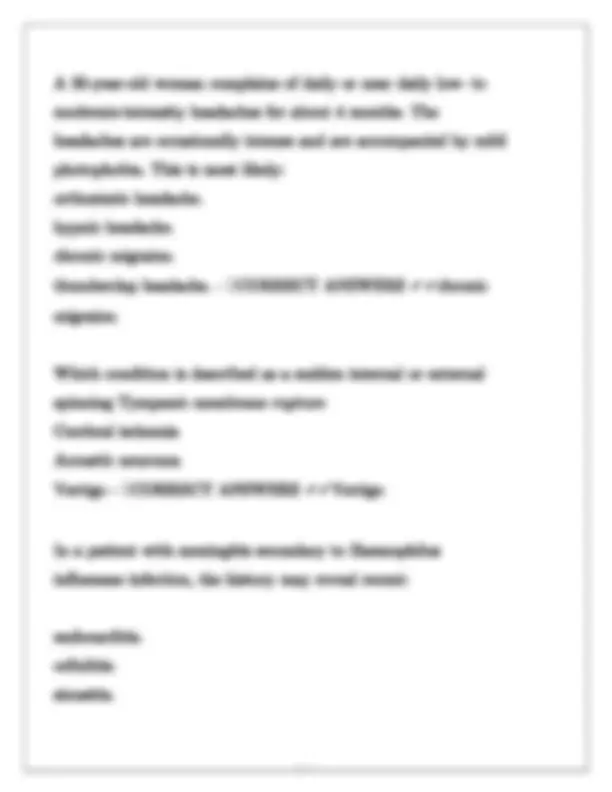
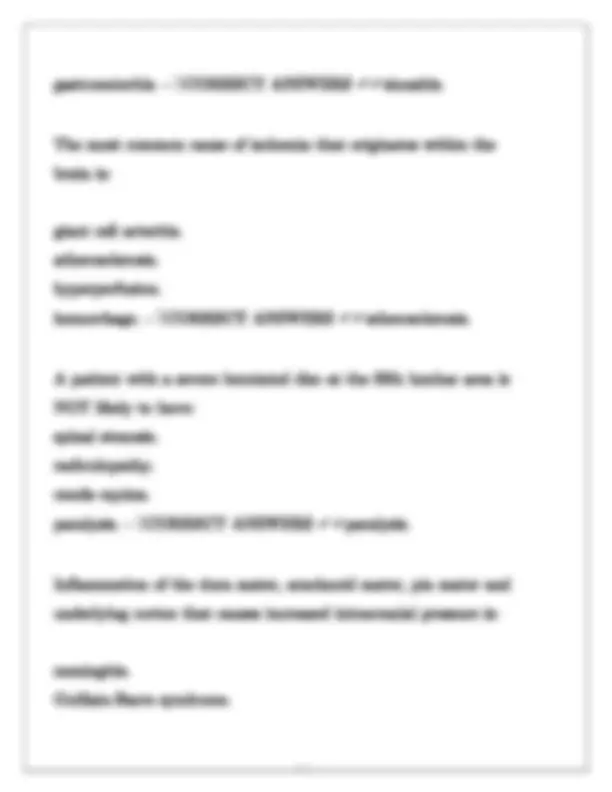
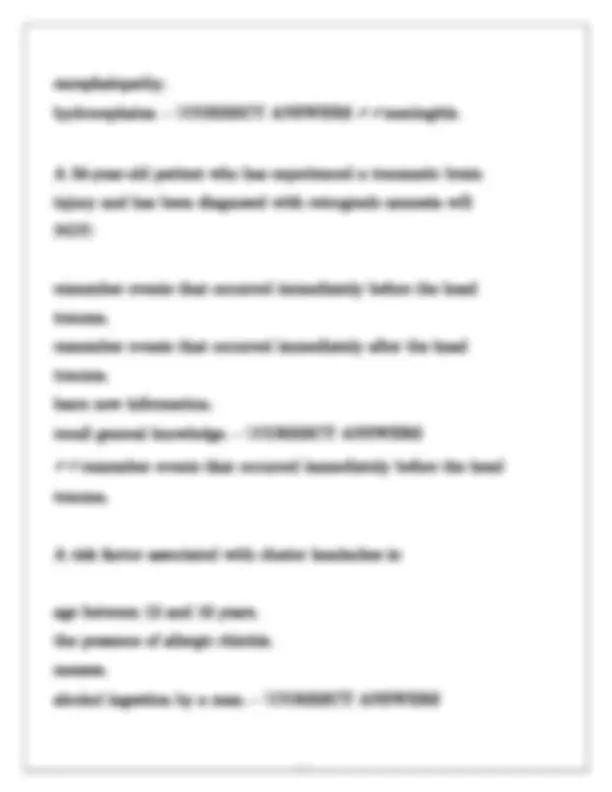
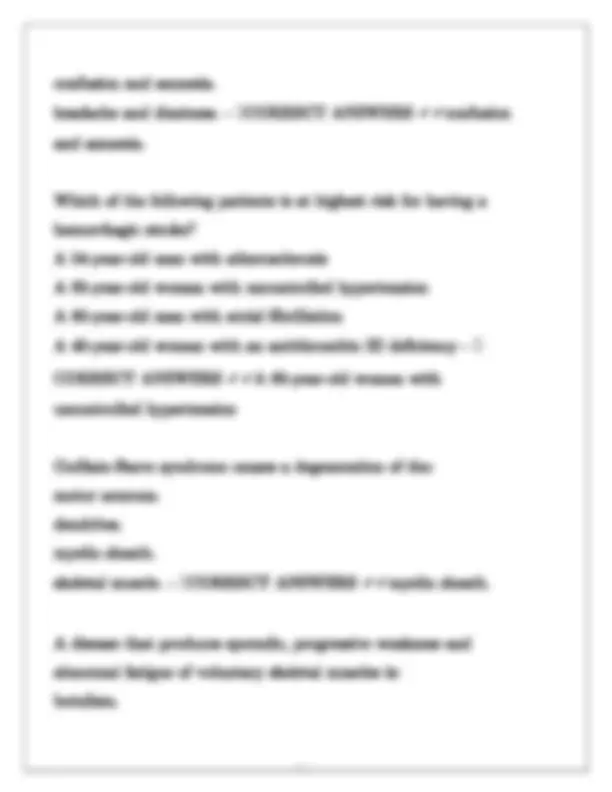
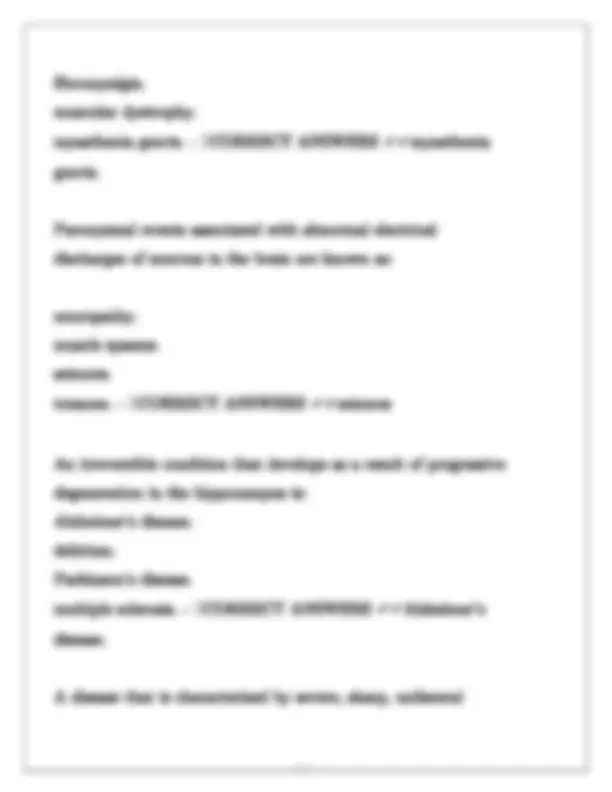
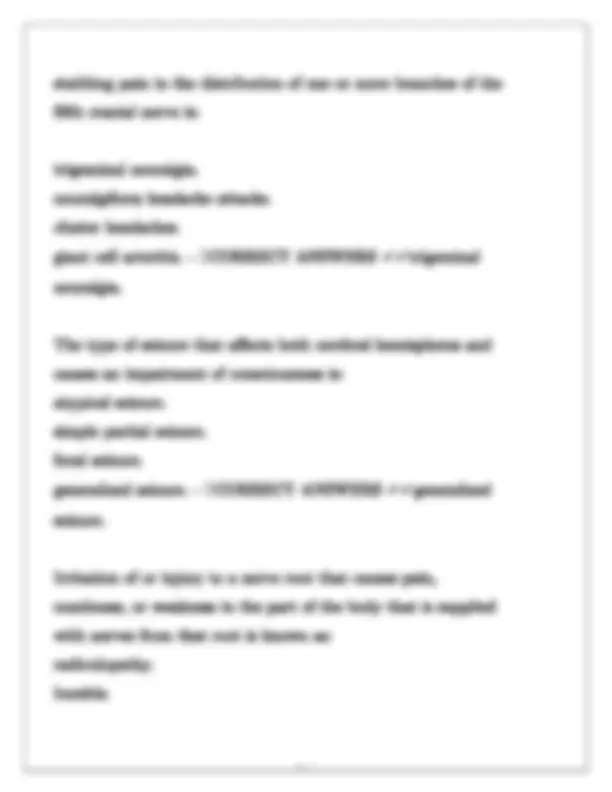

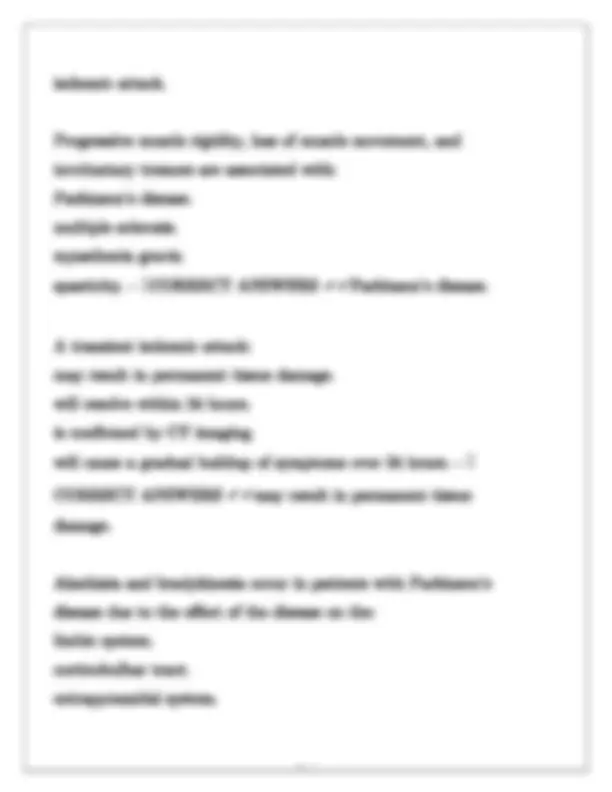
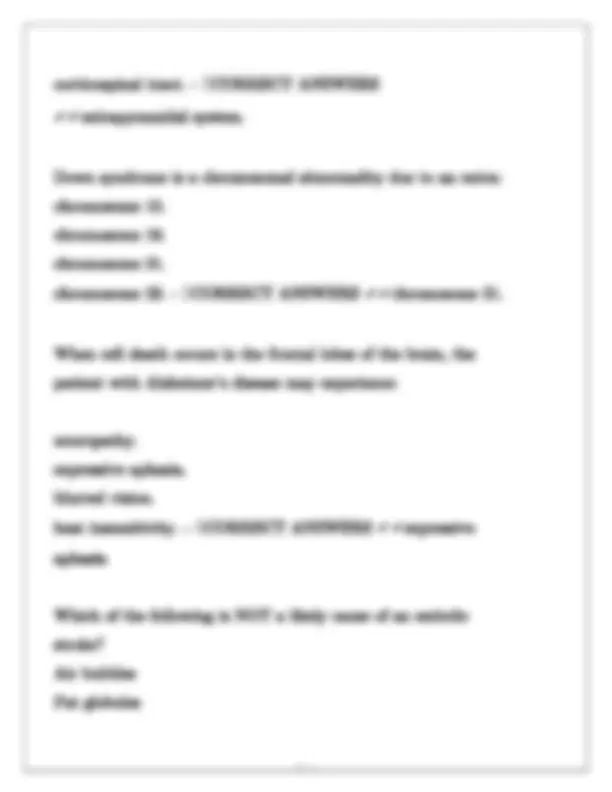


Study with the several resources on Docsity

Earn points by helping other students or get them with a premium plan


Prepare for your exams
Study with the several resources on Docsity

Earn points to download
Earn points by helping other students or get them with a premium plan
Community
Ask the community for help and clear up your study doubts
Discover the best universities in your country according to Docsity users
Free resources
Download our free guides on studying techniques, anxiety management strategies, and thesis advice from Docsity tutors
A series of multiple choice questions and answers covering various neurological conditions and concepts. it's a valuable resource for students studying neurology, offering a practical way to test their knowledge and understanding of key topics such as cranial nerve dysfunction, demyelinating diseases, meningitis, and neurodegenerative disorders. The questions cover a range of difficulty levels, making it suitable for both undergraduate and graduate-level study.
Typology: Exams
1 / 17

This page cannot be seen from the preview
Don't miss anything!










1 \\\/ \\
\ 17
A dysfunction of cranial nerve VI (abducens nerve) would likely result in: the inability to chew. lack of tongue movement. ptosis. esotropia. - 🔰 CORRECT ANSWERS ✔✔ esotropia. An acute, autoimmune, rapidly progressive demyelination of peripheral nerves is known as: myasthenia gravis. Guillain-Barre syndrome. amyotrophic lateral sclerosis. multiple sclerosis. - 🔰 CORRECT ANSWERS ✔✔ Guillain-Barre syndrome. A diagnosis of meningitis should be considered in the patient who exhibits: decreased deep tendon reflexes.
2 \\\/ \\
\ 17 positive Brudzinski and Kernig signs. an intention tremor. ptosis. - 🔰 CORRECT ANSWERS ✔✔ positive Brudzinski and Kernig signs. In a patient with parkinsonism, the loss of autonomic responses to fear and the development of depression is caused by loss of neurons in the: corpus striatum. globus pallidus. amygdala. brainstem. - 🔰 CORRECT ANSWERS ✔✔ amygdala. A progressive neurodegenerative disease that destroys motor neurons is: multiple sclerosis. amyotrophic lateral sclerosis. myasthenia gravis. Parkinson disease. - 🔰 CORRECT ANSWERS ✔✔ amyotrophic lateral sclerosis.
4 \\\/ \\
\ 17 gastroenteritis. - 🔰 CORRECT ANSWERS ✔✔ sinusitis. The most common cause of ischemia that originates within the brain is: giant cell arteritis. atherosclerosis. hyperperfusion. hemorrhage. - 🔰 CORRECT ANSWERS ✔✔ atherosclerosis. A patient with a severe herniated disc at the fifth lumbar area is NOT likely to have: spinal stenosis. radiculopathy. cauda equina. paralysis. - 🔰 CORRECT ANSWERS ✔✔ paralysis. Inflammation of the dura mater, arachnoid mater, pia mater and underlying cortex that causes increased intracranial pressure is: meningitis. Guillain-Barre syndrome.
5 \\\/ \\
\ 17 encephalopathy. hydrocephalus. - 🔰 CORRECT ANSWERS ✔✔ meningitis. A 34-year-old patient who has experienced a traumatic brain injury and has been diagnosed with retrograde amnesia will NOT: remember events that occurred immediately before the head trauma. remember events that occurred immediately after the head trauma. learn new information. recall general knowledge. - 🔰 CORRECT ANSWERS ✔✔ remember events that occurred immediately before the head trauma. A risk factor associated with cluster headaches is: age between 13 and 18 years. the presence of allergic rhinitis. menses. alcohol ingestion by a man. - 🔰 CORRECT ANSWERS
7 \\\/ \\
\ 17 traumatic hearing loss. auditory neuropathy spectrum disorder. - 🔰 CORRECT ANSWERS ✔✔ auditory neuropathy spectrum disorder. The diagnostic criteria for Alzheimer's disease include: impaired ability to remember new information. visual hallucinations. cognitive fluctuations. rapid eye movement (REM) sleep behavior disorder. - 🔰 CORRECT ANSWERS ✔✔ impaired ability to remember new information. Which diagnostic study can be useful in differentiating Alzheimer's disease from dementia with Lewy bodies? CT MRI EEG PET scan - 🔰 CORRECT ANSWERS ✔✔ PET scan Two hallmark symptoms of concussion are: nausea and vomiting. tremor and loss of consciousness.
8 \\\/ \\
\ 17 confusion and amnesia. headache and dizziness. - 🔰 CORRECT ANSWERS ✔✔ confusion and amnesia. Which of the following patients is at highest risk for having a hemorrhagic stroke? A 54-year-old man with atherosclerosis A 65-year-old woman with uncontrolled hypertension A 60-year-old man with atrial fibrillation A 40-year-old woman with an antithrombin III deficiency - 🔰 CORRECT ANSWERS ✔✔ A 65-year-old woman with uncontrolled hypertension Guillain-Barre syndrome causes a degeneration of the: motor neurons. dendrites. myelin sheath. skeletal muscle. - 🔰 CORRECT ANSWERS ✔✔ myelin sheath. A disease that produces sporadic, progressive weakness and abnormal fatigue of voluntary skeletal muscles is: botulism.
10 \\\/ \ \\ 17 stabbing pain in the distribution of one or more branches of the fifth cranial nerve is: trigeminal neuralgia. neuralgiform headache attacks. cluster headaches. giant cell arteritis. - 🔰 CORRECT ANSWERS ✔✔ trigeminal neuralgia. The type of seizure that affects both cerebral hemispheres and causes an impairment of consciousness is: atypical seizure. simple partial seizure. focal seizure. generalized seizure. - 🔰 CORRECT ANSWERS ✔✔ generalized seizure. Irritation of or injury to a nerve root that causes pain, numbness, or weakness in the part of the body that is supplied with nerves from that root is known as: radiculopathy. bursitis.
11 \\\/ \ \\ 17 cauda equina. arthritis. - 🔰 CORRECT ANSWERS ✔✔ radiculopathy. An abnormally excessive curvature of the thoracic spine is known as: lordosis. spondylosis. stenosis. kyphosis. - 🔰 CORRECT ANSWERS ✔✔ kyphosis. In myasthenia gravis, neuromuscular transmission is blocked by weakened receptor sites at which neurotransmitter? Dopamine Serotonin Acetylcholine Glutamate - 🔰 CORRECT ANSWERS ✔✔ Acetylcholine In Parkinson's disease, a deficiency exists in which neurotransmitter? Acetylcholine Dopamine Serotonin
13 \\\/ \ \\ 17 Which of the following is a disorder of the spinal nerve roots that results from compression, inflammation, or tearing of the nerve roots at the vertebral canal? Fibromyalgia Osteoarthritis Radiculopathy Osteoporosis - 🔰 CORRECT ANSWERS ✔✔ Radiculopathy Autonomic symptoms associated with cluster headaches do NOT include: ptosis. lacrimation. rhinorrhea. epistaxis. - 🔰 CORRECT ANSWERS ✔✔ epistaxis. A transient episode of neurologic dysfunction caused by focal brain, spinal cord, or retinal ischemia without acute infarction is called: transient ischemic attack. meningitis. multiple sclerosis. subdural hemorrhage. - 🔰 CORRECT ANSWERS ✔✔ transient
14 \\\/ \ \\ 17 ischemic attack. Progressive muscle rigidity, loss of muscle movement, and involuntary tremors are associated with: Parkinson's disease. multiple sclerosis. myasthenia gravis. spasticity. - 🔰 CORRECT ANSWERS ✔✔ Parkinson's disease. A transient ischemic attack: may result in permanent tissue damage. will resolve within 24 hours. is confirmed by CT imaging. will cause a gradual buildup of symptoms over 24 hours. - 🔰 CORRECT ANSWERS ✔✔ may result in permanent tissue damage. Akathisia and bradykinesia occur in patients with Parkinson's disease due to the effect of the disease on the: limbic system. corticobulbar tract. extrapyramidal system.
16 \\\/ \ \\ 17 Plaque Elevated blood sugar - 🔰 CORRECT ANSWERS ✔✔ Elevated blood sugar A complex pathophysiologic process that affects the brain and is a result of direct external contact forces is: concussion. seizure. headache. posttraumatic stress. - 🔰 CORRECT ANSWERS ✔✔ concussion The cause of movement disorders in Parkinson's disease is thought to be related to destruction of cells in the: hippocampus. substantia nigra. striatum. corpus callosum. - 🔰 CORRECT ANSWERS ✔✔ substantia nigra The hypersensitivity and pain crescendo experienced in conjunction with a migraine attack is thought to be related to the release of: catecholamines.
17 \\\/ \ \\ 17 substance P. enkephalins. acetylcholine. - 🔰 CORRECT ANSWERS ✔✔ substance P.